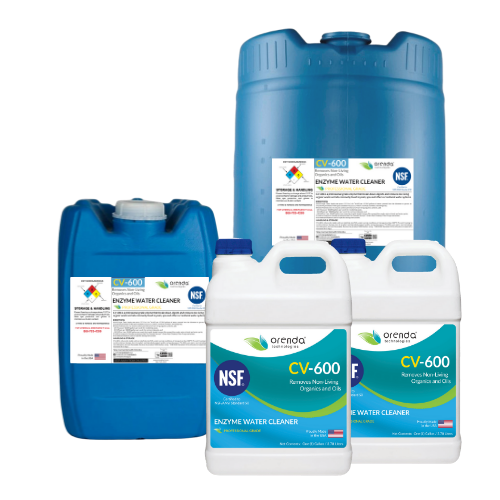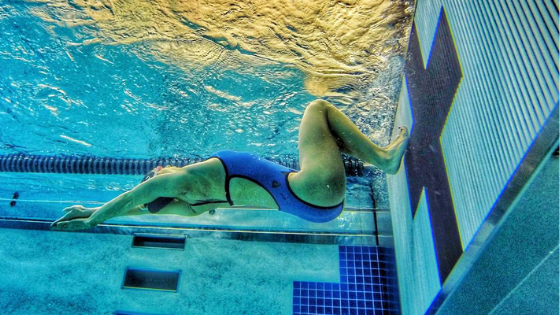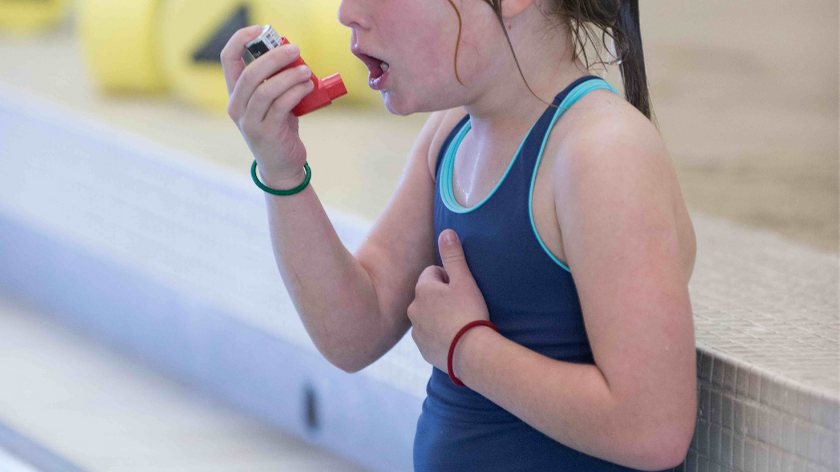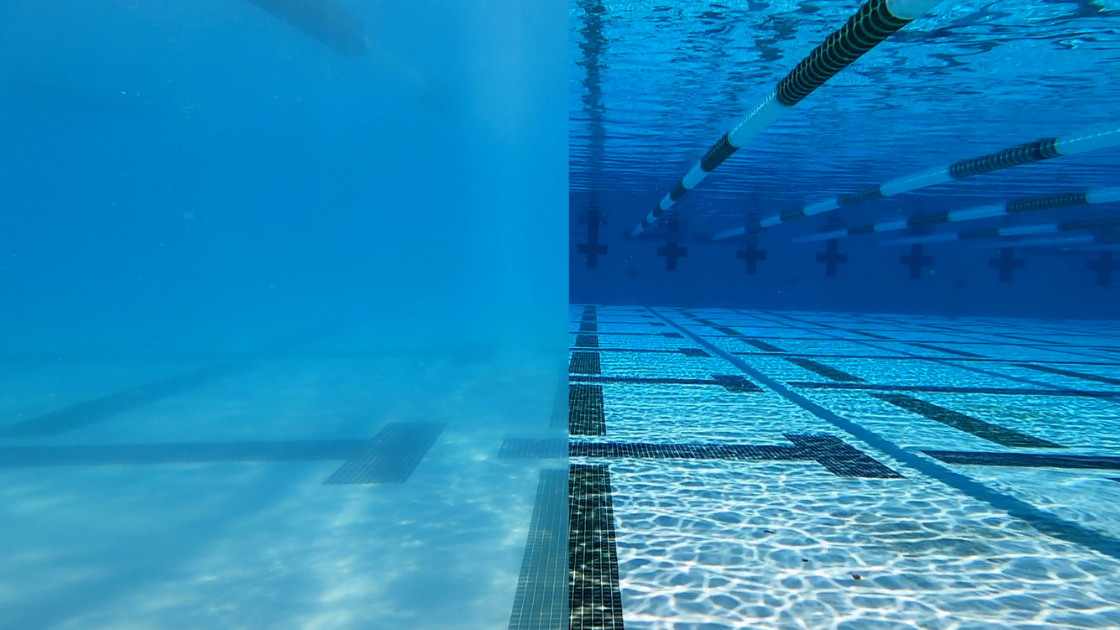Ways to Reduce Combined Chlorine
Is your combined chlorine too high? If so, you're not alone. Combined chlorine is often misunderstood, so this article expands on our previous article about it. We want to show you both the chemical and mechanical options available to help you lower combined chlorine in a swimming pool.
Covered in this article:
- What is combined chlorine?
- Organic vs. Inorganic Chloramines
- The case against using algaecides
- What is the maximum allowable level of combined chlorine? How much combined chlorine is acceptable?
- What do high combined chlorine levels mean?
- High total chlorine
- Does chlorine neutralizer remove combined chlorine?
- Does combined chlorine dissipate? Or go away on its own over time?
What is combined chlorine?
Combined chlorine is a measurement of chlorine that has combined with nitrogen compounds. This happens as a substitution reaction when chlorine is oxidizing nitrogen-based substances like ammonia. The term "combined chlorine" is often used synonymously with chloramines.

Chloride ions substitute Hydrogen as more and more Hypochlorous acid (HOCl) oxidizes inorganic ammonia. Credit: Orenda Technologies / HASA, Inc. Used with Permission.
When HOCl oxidizes ammonia, its final products are Nitrogen gas (N2) and nitrates.1 Before those are created, however, the substitution reactions in the graphic above take place, creating chloramines.
In short, if you have ANY combined chlorine in your water, there is (or was) nitrogen in your water in some form or another. Guaranteed.
Combined chlorine vs. Free Chlorine
Combined chlorine is different from free chlorine, in that free chlorine is not combined with these nitrogen compounds. Free chlorine is free and available to kill and oxidize contaminants at will. Chlorine that has combined with nitrogen has very minimal disinfection ability, because it's mostly devoted to overwhelming the nitrogen compound itself. Chlorine is made to kill germs, and it is not very good at this.
How to test for combined chlorine
How is combined chlorine measured? Unfortunately, there are no test kits that directly measure combined chlorine. Instead, we must test two factors: free chlorine, and total chlorine. We then subtract free chlorine from total chlorine. The difference between them is combined chlorine:
CC = TAC - FC
Combined chlorine = total available chlorine - free chlorine
If your total chlorine level is higher than your free chlorine, you have combined chlorine, and therefore nitrogen in your water.
There are automated controller systems that have free chlorine and total chlorine probes that allow operators to see combined chlorine in real time. These systems are highly valuable to pool operators, especially if integrated with a source-capture exhaust system.

While there is no such thing as a combined chlorine meter, free and total chlorine controller probes allow it to be calculated. Because of this real-time feedback, combined chlorine is a reliable way to track bather load, as all bathers introduce at least some nitrogen and organics into the water. Body oils and sweat alone can increase combined chlorine in a measurable way. This is why it is recommended that swimmers rinse off in the shower before getting in the pool.
A larger contributor than sweat is urine. Swimmers pee in pools regularly, even though it's disgusting. It's a part of the swimming culture, and that culture would have to change before the problem will go away.
When we see combined chlorine values over 0.5 ppm, however, it's unlikely just from swimmers. Levels exceeding 1.0 ppm are almost certainly involving nitrogen-based chemicals getting into the pool. A common source of this is pool deck cleaners, where wet swimmers walk on the deck, and track in the floor cleaning chemical residue into the pool. Evaluating such chemicals is one of the things we do in our in-person facility evaluations.
Also, as mentioned earlier, if non-chlorine algaecides are used (hopefully never), the combined chlorine levels can be several parts per million, and the pool could be shut down by local health inspectors.
Organic chloramines vs. Inorganic Chloramines
The graphic shown above shows the process of chlorine combining with inorganic ammonia (NH3). There is no carbon in it, so it is considered inorganic. When carbon is part of the compound, it becomes organic, and the chemistry becomes more complex.
It already takes a lot of chlorine to get rid of ammonia, so you can imagine how much more chlorine would be required to break down an organic nitrogen compound like urea:

Graphic: Illustration of a molecule of ammonia (inorganic nitrogen compound) compared to urea (organic nitrogen compound). Credit: Orenda Technologies / HASA, Inc. Used with permission.
Achieving breakpoint chlorination with organic nitrogen leaves behind significantly more varieties of harmful byproducts. Here is just a glimpse of all the reactions that take place for chlorine to remove urea from water. Every step of the way consumes more chlorine and creates more harmful byproducts:

Graphic: Screenshot from an Orenda® presentation on chemical conflicts. Original source: Lowry, Robert W.(2016). IPSSA Intermediate Training Manual, Part 1 - Chemicals. Used here with permission from Orenda / HASA, Inc.
The case against using algaecides
It should go without saying that the more complex the nitrogen compound, the more chlorine consumed, and the more byproducts produced. Many of these byproducts are known to be harmful. The pool industry uses the term "chloramines" generically to describe all of them, but in reality, there are hundreds upon hundreds of possible byproducts created.
And if you thought Urea was complicated...how much more complex are some of the algaecides sold in the pool industry?

Graphic: Screenshot of a Watershape University® class (Service 2211: Essential Water Chemistry), showing the chemical formulas of common pool algaecide products and their active ingredients. Pink represents nitrogen-based substances, and turquoise represents carbon-based (organic) substances. As you can see, these algaecides are highly complex (moreso than urea!). What byproducts do you think will be lurking in your water after using them? Credit: Watershape University®. Used with Permission.
We strongly advise against using algaecide (sometimes spelled algicide) products in swimming pools. Not because they don't kill algae...but because of the harmful long-term byproducts they leave behind in the water.
What is the maximum allowable level of combined chlorine? How much combined chlorine is acceptable?
The ideal combined chlorine level is zero (0 ppm). Most health departments around the country limit combined chlorine to 0.2 or 0.5 ppm. At 0.5 ppm, pools can be shut down, depending the local health code.
Some municipal drinking water treatment plants around the country intentionally add ammonia to drinking water to create chloramines. According to the EPA, this intentional chloramination is done for a few reasons. One is to extend the distance water can travel from the plant and still carry some disinfection ability. Monochloramine is much slower than Hypochlorous acid (HOCl).? The main reason cited is that monochloramine is less reactive, and therefore leaves fewer byproducts in the water.2
Many of our homes have chloramines in the tap water as a result. Not only are we (and our pets) drinking these, we're also cooking with it, cleaning with it, and showering in it. We recommend investing in measures to remove chloramines before consuming them, either by installing an activated carbon filter or UV system in your home.
What do high combined chlorine levels mean?
Again, any amount of combined chlorine means your water has (or had) nitrogen in it. In our opinion, "high" combined chlorine means levels exceeding 0.2 ppm. Very high would be over 0.5 ppm, the threshold where most health inspectors can shut commercial pools down. If you have levels exceeding 0.5 ppm, it's most likely a chemical conflict, not just high bather load. But we have seen combined chlorine over 10 ppm before. At that point, we know there's a chemical conflict. Usually ammonia-based algaecides and/or deck cleaners.
We have been hired by countless aquatic facilities that struggled with both air quality and high combined chlorine over 0.5 ppm. The air quality issues are a consequence of the combined chlorine, but they are also an air issue that cannot be solved by water chemistry alone. In each case, we helped modify their HVAC system and duct design. As for the water, however, addressing combined chlorine is simpler than you might think.
The clients we're referring to did not need radical changes in their system to correct their chemistry. They just needed to think differently and swap some chemicals out for more compatible ones. This often includes exchanging deck cleaning chemicals for sodium hypochlorite-based cleaners, abandoning algaecides, and implementing a regiment of enzymes to break down organic compounds into simpler inorganic compounds.
High total chlorine
Some pools struggle with high total chlorine, even though their free chlorine is getting used. This is an indication that breakpoint chlorine is not being achieved, meaning your chlorine is falling behind. It cannot quite exceed the threshold (breakpoint) where it can destroy chloramines. So the total chlorine level climbs and climbs, and the gap between it and the free chlorine level grows.
Your chlorine is fighting a significant enough oxidant demand that its ability to sanitize is becoming compromised. This is a potential problem for the health and safety of bathers, since chlorine is the primary sanitizer. It's our first line of defense against Recreational Water Illnesses (RWIs).
Combined chlorine levels are also a reliable metric that tells us additional information–much like ORP does. We can tell instantly how efficient (or inefficient) our chlorine is.
But as far as indoor air quality is concerned, combined chlorine is the closest measurement we have for knowing the rate and severity of airborne chloramine production. The higher the combined chlorine, the worse the air is going to smell. So it behooves pool operators to take combined chlorine seriously; try to mitigate it in the first place, and reduce it when it climbs.
Does chlorine neutralizer remove combined chlorine?
If the total chlorine is too high, some pool operators will default to adding a chlorine neutralizer like sodium thiosulfate. While this does neutralize chlorine, it does not remove the nitrogen compounds from the pool. As you resume chlorination, the total chlorine will once again climb faster than free chlorine, and you're back to square one.
So no, chlorine neutralizer does not solve the problem. If anything, it complicates things.
Does combined chlorine dissipate? Or go away on its own over time?
Eventually combined chlorine will be overpowered by free chlorine, assuming the pool continues to be chlorinated. That being said, if the source(s) of nitrogen are not addressed, that same chlorination will continue to add to combined chlorine, so you will not see progress.
But let's say for this example, you cut off the nitrogen source completely. Then yes, over time, enough chlorine will destroy chloramines. The nitrates they leave behind, however, will not go away. They need to be drained out, as there is no chemical that can safely remove nitrates, and they cannot be further oxidized.
How to reduce combined chlorine
Here's what to do if total chlorine is higher than free chlorine: instead of focusing on the symptom (combined chlorine), focus on the cause: try to identify the source(s) of nitrogen getting in your water. Then think about ways to prevent that nitrogen from getting into the water in the first place.
If you want to get rid of combined chlorine in a pool, there are a few options. Generally, there are two ways to lower combined chlorine that we will discuss here: chemically and physically.
How to chemically reduce combined chlorine
Superchlorination is by far and away the most widely used and accepted practice for addressing combined chlorine. Superchlorination is dumping an excess of free chlorine (the industry standard is 10x the level of combined chlorine, though that's more than necessary) into the pool. This surge of oxidizing power should destroy the oxidant demand. It also kills just about everything that might be lurking in the water too, which is a plus.
The downside is that the pool must be closed for superchlorination, and when it's done, the FAC level needs to be brought back down, or wait long enough for it to drift down on its own.
With respect to the breakpoint chlorination process, superchlorination is the rocket boost that finally pushes past the demand, achieving and exceeding the breakpoint, and building a free chlorine residual. In the chart above, when chlorine struggles to get over the hump at point (B), superchlorination is a reliable option.
Non-chlorine shock like potassium monopersulfate can be added to the water. This can help oxidize nitrogen precursors to chloramines, but it will not disinfect anything, nor will it destroy chlorine that has already combined to nitrogen. But there is an noticeable benefit to using it to boost oxidation in the water. Use only as directed when bathers are not in the pool. Non-chlorine shock is a powerful oxidizer.
 Enzymes do not directly reduce combined chlorine, but they directly supplement chlorine against non-living organic bather waste. Enzymes metabolize carbon-based body products like body oils, deodorants, cosmetics, lotions and sunscreen. That way, chlorine has less to oxidize. Less oxidant demand means more chlorine in the war against nitrogen compounds.
Enzymes do not directly reduce combined chlorine, but they directly supplement chlorine against non-living organic bather waste. Enzymes metabolize carbon-based body products like body oils, deodorants, cosmetics, lotions and sunscreen. That way, chlorine has less to oxidize. Less oxidant demand means more chlorine in the war against nitrogen compounds.
So while enzymes like CV-600 do not directly address nitrogen compounds like ammonia and urea, they can bring an enormous improvement in chlorine efficiency. Let's go back to the earlier section of this article for a moment where we compared inorganic vs. organic chloramines. Remember how much more complex organic nitrogen compounds (like urea) are? Enzymes do not touch the nitrogen itself, but they will break down the carbon bonds and remove them.
Removing carbon with enzymes radically simplifies the molecules, lowering the energy required for chlorine to address the inorganic nitrogen. So while enzymes do not directly reduce combined chlorine (because they do not remove nitrogen), the net effect to a pool operator appears that way. We regularly recommend using enzymes to not only help reduce combined chlorine, but also to improve indoor air quality.
Related: Pool Water Chemistry Resources
There are some other chemicals that have been explored, but are not yet proven to be safe enough for use in swimming pools. One of them is chlorine dioxide, which is a very powerful form of chlorine, capable of destroying chloramines with relative ease. It is not used in commercial pools at this time, however, but it is popular in other industries.
How to physically reduce combined chlorine
Dilution is a viable option for pools that have no chloramines in their fill water. Simply draining or backwashing water to waste makes room for tap water to replace it.
This is also viable even if you have some chloramines in the tap water, assuming your fill line feeds water into the surge tank or pre-filter on a pool with a UV, ozone, or AOP secondary system. The secondary system will destroy the chloramines before they make it into the pool.

Secondary disinfection systems like UV and Ozone are quite popular in commercial pools. Ultra Violet (UV) systems can destroy formed chloramines, but not the nitrogen compounds themselves.

UV itself is not an oxidizer. It is a secondary sanitizer that disrupts cells and prevents them from reproducing. It also happens to break apart combined chlorine molecules (monochloramine and dichloramine).
Once trichloramine is formed and off-gassed, UV can no longer touch it...for obvious reasons. This means UV has a limited impact on indoor air quality. But if trichloramine does stay waterborne long enough to pass through a UV chamber, it will be destroyed. UV, for this reason, is our recommendation for indoor pools. It is less effective in outdoor pools because people tend to wear sunscreen, and sunscreen blocks UV.
Related: Comparison of the Best Secondary Systems for Swimming Pools
Ozone is also a point-of-contact system, like UV, so ozone also has a limited impact on indoor air quality. One advantage ozone has over UV, however, is that ozone will oxidize and destroy just about anything. Yes, that includes nitrogen compounds, organic bather waste, and waterborne chloramines.
Ozone is also a powerful sanitizer that can kill germs and diseases. Ozone is the clear favorite for outdoor pools.
Advanced Oxidation Process (AOP) is similar to Ozone, in that it is a point-of-contact oxidizer. It has the ability to destroy pathogens and oxidize nitrogen compounds too.
Hyper-Dissolved Oxygen (HDO) is a relatively recent technology in the pool industry, though it has been around for many years in other industries like food processing and agriculture. It injects hundreds of millions of nanobubbles of purified oxygen into solution; bubbles so small they can stay in solution for days.

Image: Hyper-dissolved Oxygen (AquaFuzion®) installed on a high-end residential pool. Photo courtesy of Pure Vision Technologies. Used with permission.
This means HDO is not just a point-of-contact system. Oxygen helps boost chlorine and enzyme activity. So while the oxygen itself does not reduce combined chlorine, it boosts chlorine, which does. Air quality, however, is where HDO stands out. There is a noticeable improvement to indoor air quality using HDO. This is largely because there is so much oxygen in the water, that when it off-gasses, it introduces pure oxygen above the surface of the water (right in the breathing zone). Fresh air dilutes chloramine gases. We know from personal experience that it dramatically improves indoor air quality...despite not reducing chloramines.
Conclusion
Combined chlorine is a measurement of chlorine that has combined with nitrogen compounds. We generally refer to all of these molecules as chloramines, even though chloramines are just one specific group. There are more disinfection byproducts (DBPs) that we can list on here. The variations happen, in part, because of incomplete oxidation. When chlorine runs out of steam after halfway destroying something, you're left with a half-destroyed byproduct.
You can reduce combined chlorine physically using dilution or secondary systems (UV, ozone, AOP). You can chemically reduce combined chlorine utilizing superchlorination to exceed the breakpoint, and you can supplement that effort using non-chlorine shock and/or enzymes.
It's easy to think that indoor air quality can be "perfect" if the water quality is perfect. But that's simply not true. If the air quality happens to be great, it's because the air system is also well-designed. Water and air quality must be in harmony. Too often, we see indoor pools with HVAC systems that do not match the needs of the pool they serve.
Does your facility have challenges with combined chlorine and indoor air quality? If so, you're not alone. Let us know if you want help properly diagnosing the issues so you can solve them at their source.
1 Based on a conversation with Dr. Ernest Blatchley
2 According to the US Environmental Protection Agency (EPA), there are a few reasons why water utilities use monochloramine intentionally. Part of it is to extend the reach of the water and still have some disinfection. The main reason they cite, however, is monochloramine is less reactive and therefore leaves less other byproducts in the water compared to chlorine. Counter-intuitive, right? Monochloramine itself IS a chlorine byproduct. In fairness, it's less harmful than many of the other chlorine disinfection byproducts like cyanogen chloride, trichloromethane (chloroform), and dozens of other variations.

 By
By




